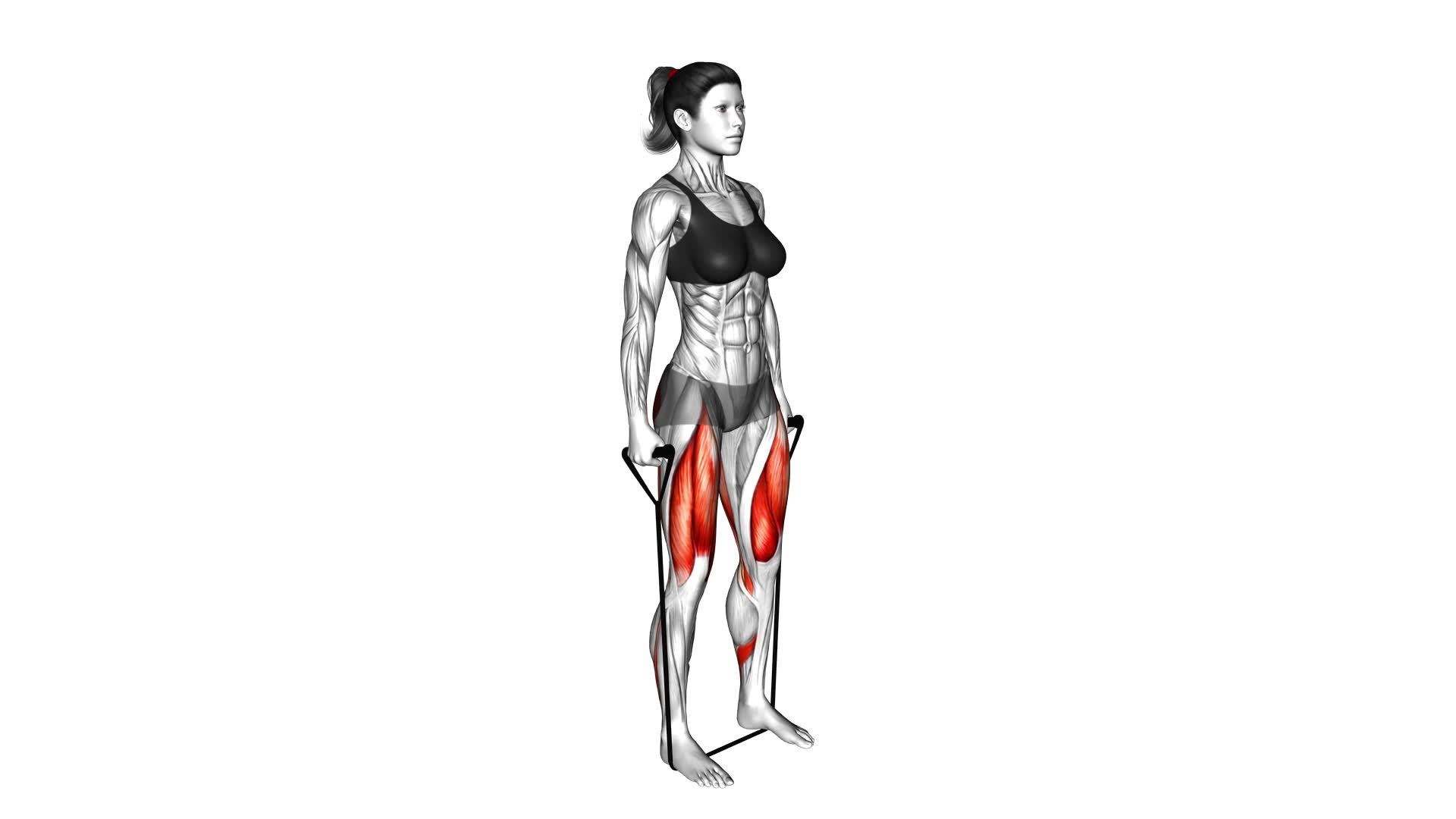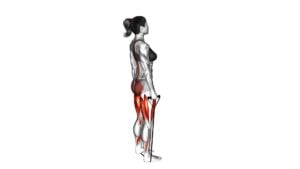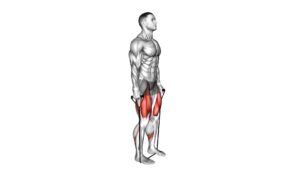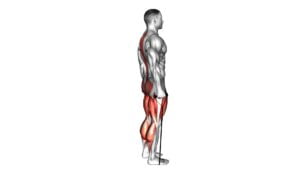Band Deadlift (female) – Video Exercise Guide & Tips

Looking to strengthen your lower body and improve your overall fitness? The Band Deadlift is the perfect exercise for you! In this video exercise guide, we'll show you the proper form, variations, and progressions of the Band Deadlift.
Watch This Exercise Video
Learn how to choose the right resistance band and avoid common mistakes. With our tips, you'll be able to safely and effectively perform the Band Deadlift, taking your workouts to the next level.
Let's get started!
Key Takeaways
- Band deadlift engages and strengthens the entire posterior chain (glutes, hamstrings, lower back).
- Proper form and technique are crucial, including maintaining a neutral spine and engaging the core throughout the movement.
- Choosing the right resistance band is important, considering the type, tension, and personal preferences.
- There are variations and progressions of band deadlifts that can target different muscle groups and increase difficulty as strength improves.
Benefits of the Band Deadlift
To maximize your gains and strengthen your posterior chain, performing the band deadlift is an effective way to target multiple muscle groups simultaneously. The band deadlift offers a range of benefits that can enhance your overall fitness and strength training routine.
One of the main benefits of the band deadlift is its ability to engage and strengthen your entire posterior chain, which includes the muscles in your glutes, hamstrings, and lower back. By using resistance bands, you add an extra challenge to the movement, increasing the intensity and forcing your muscles to work harder. This can lead to improved muscle activation and development in these areas.
Additionally, the band deadlift helps to improve your core stability and balance. As you lift the weight, you're required to engage your core muscles to maintain proper form and balance. This can help to enhance your overall stability and prevent injuries.
Technique is crucial when performing the band deadlift to ensure maximum benefits and minimize the risk of injury. Start by standing on the resistance band with your feet hip-width apart. Hold the bands in your hands, with your palms facing inward. Bend at the knees and hips, keeping your back straight, and lower the weights towards the ground. Push through your heels to stand back up, extending your hips forward. Remember to maintain proper form throughout the movement, keeping your core engaged and your back straight.
Proper Form for the Band Deadlift
To perform the band deadlift with proper form, ensure that you maintain a neutral spine and engage your core throughout the movement. This is crucial for preventing injuries and maximizing the benefits of the exercise.
One common mistake to avoid is rounding your back during the lift. This can put excessive stress on your spine and increase the risk of injury. Instead, focus on keeping your back straight and your chest lifted throughout the entire movement.
Another mistake to watch out for is using too much weight or resistance, which can compromise your form and lead to muscle imbalances or strains. Start with a lighter resistance band and gradually increase the tension as your strength improves.
Additionally, it's important to maintain proper alignment of your knees and hips. Avoid letting your knees collapse inward or allowing your hips to rise too quickly, as this can place strain on your joints.
Choosing the Right Resistance Band
To choose the right resistance band for your band deadlift exercise, consider your current strength level and select a band that provides an appropriate level of tension. Here are three factors to consider when choosing a resistance band:
- Resistance band types: Resistance bands come in various types, including loop bands, tube bands, and figure-eight bands. Loop bands are circular and can be used for a wide range of exercises, while tube bands have handles and allow for more versatility in movement. Figure-eight bands are typically used for lower body exercises like the band deadlift.
- Resistance band sizing: Resistance bands are typically color-coded to indicate their level of resistance. It's important to choose a band with the right amount of tension for your current strength level. If you're a beginner, start with a lighter resistance band and gradually increase the tension as you get stronger.
- Personal preference: Consider your personal preferences when choosing a resistance band. Do you prefer the feel of a loop band or the versatility of a tube band? Do you like a certain brand or material? Finding a resistance band that you enjoy using can make your band deadlift exercise more enjoyable and effective.
Variations and Progressions of the Band Deadlift
Consider incorporating different variations and progressions of the band deadlift to challenge your muscles and continue making strength gains. By adding progressions and modifications to your band deadlift routine, you can target different muscle groups and increase the difficulty of the exercise.
One variation of the band deadlift is the staggered stance deadlift. To perform this variation, place one foot slightly in front of the other and maintain a stable base. This stance will engage your core and challenge your balance while performing the deadlift movement.
Another progression is the single-leg band deadlift. This variation requires greater stability and strength in the glutes and hamstrings. Start by standing on one leg with the resistance band securely anchored. Keep your back straight and hinge forward at the hips, extending the non-standing leg behind you. This exercise won't only target your posterior chain but also improve your balance and stability.
For those looking for an advanced progression, the banded deficit deadlift is a great option. This variation involves standing on a step or platform, increasing the range of motion and making the exercise more challenging. The band provides additional resistance, further engaging your muscles.
Incorporating these variations and progressions into your band deadlift routine will help you continuously challenge your muscles and make progress in your strength training journey. Remember to start with the appropriate resistance band for your fitness level and gradually increase the difficulty as you become stronger.
Common Mistakes to Avoid
To maximize the benefits of the band deadlift and avoid common mistakes, it's crucial to focus on proper form demonstration and injury prevention techniques.
By maintaining a neutral spine, engaging your core, and keeping your weight evenly distributed, you can ensure that you're performing the exercise correctly.
Additionally, it's important to avoid rounding your back, using excessive momentum, or lifting too heavy of a weight, as these can lead to potential injuries.
Proper Form Demonstration
Avoid these common mistakes when performing the band deadlift exercise to ensure proper form and prevent injury:
- Rounded back: One of the most common mistakes is rounding the back during the movement. This puts excessive stress on the spine and can lead to injuries. Keep your back straight and engage your core to maintain proper alignment.
- Lifting with your back: Instead of using your leg muscles to lift the weight, some people rely on their back muscles. This can result in strain and potential injury. Focus on pushing through your heels and using your glutes and hamstrings to power the movement.
- Not using the band correctly: The band should be securely looped around your feet and held with tension throughout the exercise. Make sure it isn't too loose or too tight, as this can affect your form and compromise the effectiveness of the exercise.
Injury Prevention Techniques
To prevent injury during the band deadlift exercise, focus on maintaining proper form and avoiding common mistakes. Injury prevention techniques are crucial to ensure a safe and effective workout.
One common mistake to avoid is rounding your back during the movement. This can put excessive strain on your spine and increase the risk of injury.
Another mistake is lifting too heavy of a weight or using improper band tension. Start with a lighter resistance band and gradually increase as you build strength and confidence.
Additionally, be mindful of your foot placement and avoid letting your knees cave inwards. Engage your core, keep your chest lifted, and use your glutes and hamstrings to power through the movement.
Tips for a Safe and Effective Band Deadlift
For a safe and effective band deadlift, ensure that you're properly positioning your feet and gripping the bands firmly. Here are some tips to help you perform the exercise correctly:
- Exercise modifications: If you're new to band deadlifts or have certain limitations, you can modify the exercise to suit your needs. For example, you can use lighter resistance bands or start with a partial range of motion until you feel comfortable with the movement. Additionally, you can perform the exercise with a wider stance to target different muscles.
- Warm up exercises: Before starting your band deadlifts, it's essential to warm up your body to prepare for the workout. Incorporate dynamic stretches and mobility exercises to increase blood flow, improve joint mobility, and activate the muscles you'll be using during the deadlift. Some effective warm-up exercises include glute bridges, bodyweight squats, and hip rotations.
- Proper form and technique: Remember to maintain a neutral spine throughout the movement, engage your core, and avoid rounding your back. Push through your heels as you stand up, keeping your chest up and shoulders back. Control the descent of the bands and avoid locking out your knees at the top of the movement.
Frequently Asked Questions
How Many Sets and Reps Should I Do for the Band Deadlift?
For the band deadlift, it's important to focus on proper form and technique. Start by discussing the number of sets and reps you should do.
It's recommended to start with 3 sets of 8-10 reps, but this can vary depending on your fitness level and goals.
Remember to maintain a neutral spine, engage your glutes and hamstrings, and keep tension on the band throughout the movement.
Consult a fitness professional for personalized guidance on band deadlift variations.
Can I Use a Resistance Band for Other Exercises Besides the Deadlift?
Yes, you can definitely use a resistance band for other exercises besides the deadlift. Resistance bands are versatile tools that can be used for a wide range of exercises, such as squats, lunges, shoulder presses, and bicep curls.
The benefits of resistance band exercises include improving strength, flexibility, and stability. They're also portable and convenient, making them a great option for home workouts or when you're on the go.
What Are Some Alternative Exercises That Target the Same Muscles as the Band Deadlift?
Looking for alternative exercises that target the same muscles as the band deadlift? Resistance band training offers a variety of options.
You can try exercises like band squats, band hip thrusts, or even band glute bridges. These exercises engage similar muscle groups as the band deadlift, such as the glutes, hamstrings, and quads.
The benefits of resistance band training include increased strength, flexibility, and stability. So give these alternative exercises a try and see the difference in your workout routine.
Is It Necessary to Warm up Before Performing the Band Deadlift?
Yes, it's necessary to warm up before performing the band deadlift.
Incorporating resistance bands in your warm up routine has several benefits. It helps activate the muscles you'll be using during the exercise and increases blood flow to those areas. This can improve your performance and reduce the risk of injury.
Common mistakes to avoid while performing the band deadlift include rounding your back and using too much weight. Proper form is crucial for maximum effectiveness and safety.
Can I Use Multiple Resistance Bands to Increase the Difficulty of the Exercise?
Yes, you can definitely use multiple resistance bands to increase the difficulty of the exercise. Incorporating resistance bands into your band deadlifts can provide added resistance, helping to challenge your muscles and make the exercise more effective.
Using multiple bands can further intensify the workout, allowing you to target different muscle groups and increase overall strength and stability. It's a great way to amp up the difficulty and maximize the benefits of your band deadlifts.
Conclusion
In conclusion, the band deadlift is a highly effective exercise for women that offers numerous benefits, including:
- Strengthening the lower body
- Improving overall stability
By using the proper form and choosing the right resistance band, you can maximize the results of this exercise. Remember to avoid common mistakes and follow the tips provided for a safe and effective band deadlift.
Incorporate variations and progressions to continually challenge yourself and achieve your fitness goals.

Author
Years ago, the spark of my life’s passion ignited in my mind the moment I stepped into the local gym for the first time. The inaugural bead of perspiration, the initial endeavor, the very first surge of endorphins, and a sense of pride that washed over me post-workout marked the beginning of my deep-seated interest in strength sports, fitness, and sports nutrition. This very curiosity blossomed rapidly into a profound fascination, propelling me to earn a Master’s degree in Physical Education from the Academy of Physical Education in Krakow, followed by a Sports Manager diploma from the Jagiellonian University. My journey of growth led me to gain more specialized qualifications, such as being a certified personal trainer with a focus on sports dietetics, a lifeguard, and an instructor for wellness and corrective gymnastics. Theoretical knowledge paired seamlessly with practical experience, reinforcing my belief that the transformation of individuals under my guidance was also a reflection of my personal growth. This belief holds true even today. Each day, I strive to push the boundaries and explore new realms. These realms gently elevate me to greater heights. The unique combination of passion for my field and the continuous quest for growth fuels my drive to break new ground.







